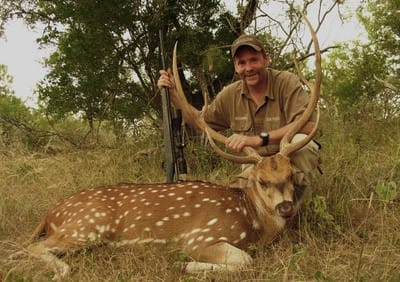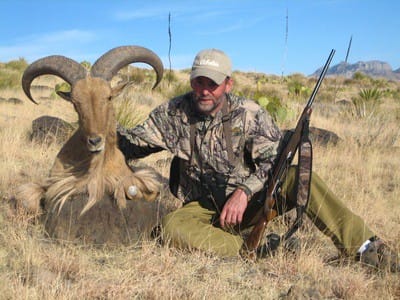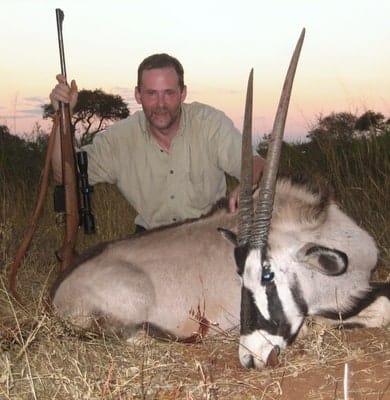
Exotic is a term used to describe animals not indigenous to or that have been introduced into a certain area. The hunting of exotic animals is most often associated with a high fence ranch. This is common in Texas and the size of these ranches can range from a few hundred acres up into the thousands. All hunters have their own opinion of what constitutes fair chase hunting. What’s important to understand is that “fair chase” has nothing to do with the animal hunted and everything to do with the method in which it is done.
Axis deer were introduced in the United States in the 1930s and have thrived. They are the most common non-indigenous ungulate found in North America. Over the years axis deer escaped game ranches and there have also been free range introductions. Today axis deer are found running wild over much of Texas.
My first axis deer hunt was on a large ranch in Texas near the South Llano River and the only fence there was a low cattle fence. The axis deer that frequented the ranch could have walked to West Virginia had they been of a mind to. I hunted from a box blind set up near a feeder and while this is a common practice for hunting whitetails, especially in the South, it’s not my favorite way to hunt. Near dark a nice buck walked out and I whacked him with a .257 Roberts.
Conversely, several years later I again hunted axis deer in Texas but this time it was behind a high fence that surrounded thousands of acres. We hunted strictly by spot and stalk and finding an axis buck and getting close enough for a shot proved quite difficult. It was a thoroughly enjoyable hunt and that axis tasted just as good as the first one.
One of the appealing facets of axis deer is that they can breed year round. Axis bucks grow and shed one set of antlers per year but they do so based on when they were born and this can be at any time. What this means is at any given time bucks in the same group can be seen with no antlers, velvet antlers or hard antlers, so axis hunting is not restricted to just a few months each year.
Axis deer are not the only free ranging exotic animal you can hunt in Texas. One of the most enjoyable hunts I’ve ever had was for free ranging aoudad or Barbary sheep. Aoudad run wild in the mountains of West Texas and they are considered by many to be the poor man’s sheep. This is changing though because hunters are learning how difficult and rewarding a hunt for a trophy, free ranging aoudad can be. Today you can expect to pay around $ 4000 or more for a respectable, guided, free-range aoudad hunt.

The blackbuck and gemsbok are two more free ranging exotic antelope species that can be hunted in Texas. As a matter of fact, there are more blackbuck in Texas than in India, where they are now considered endangered.
Gemsbok were introduced to the White Sands Missile Range in New Mexico in 1969. The have established additional territory off the range and into Texas. Each year the New Mexico Fish & Game issues a limited number of hunting permits for these “oryx” as they are also known. Gemsbok are one of Africa’s most magnificent trophies and a free ranging North American hunt for gemsbok can be very similar to and in some cases more challenging than what you might experience in South Africa.

One of the most widely hunted exotic animals in North America is the feral hog. The domestic pig was introduced to the Americas by the Spanish explorer DeSoto in the 1500s. Those that escaped became feral and were hunted for food. Later, when the wild boar was introduced throughout the U.S., they bred with the feral hogs. Few hunters consider the wild hog an exotic but just like the axis, aoudad, gemsbok and blackbuck, it was introduced to America from another country.
When it comes to hunting ethics we must all make our own decision as to what is and is not acceptable. For example, in some counties in eastern Virginia it is perfectly legal to hunt whitetail deer with dogs and in South Africa where hundreds of Americans go on safari they will find that most of the hunting is conducted on high fence concessions. Some of these concessions are as amazingly small as others are large. I hunted wildebeest there last year behind a high fence that enclosed more than 25,000 acres.
What hunters should not do is discount the hunting of exotics as unethical or easy just because they are exotics. What is important, regardless of whether the game animal is an exotic or a whitetail, is the method in which the hunt is conducted and the interaction between the hunter and the hunted. With a bit of research you can find a suitable location where you can have an ethical hunt for animals that less than 100 years ago were not even on this continent.



